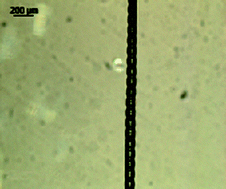Relief structures are created on the surface of fibres to generate new effects in these fibres. More specifically, photo-embossing is used to generate the relief structures and to generate a non-contact process without etching procedures which could eventually be applied in high-speed and continuous spinning lines. Typically, a photopolymer mixture consisting of a polymeric binder, a monomer and a photo-initiator is directly spun into a monofilament fibre. The rheological properties of the photopolymer mixture are measured, and it is shown that the photopolymer mixture is visco-elastic at elevated temperatures. Fibres are prepared from the photopolymer mixture, and surface relief structures are generated perpendicular to the fibre axis by photo-embossing using a mask exposure. Optical microscopy (OM) and scanning electron microscopy (SEM) are employed to study the surface morphology of the fibres. It is shown that the height of the surface relief structures is strongly dependent on the pitch of the line mask and on the diameter of the fibres. At optimized conditions, patterned fibres are produced with well-defined surface relief structures. The fibres are rather brittle which is related to the crosslinked chemical network in the fibres.

You have access to this article
 Please wait while we load your content...
Something went wrong. Try again?
Please wait while we load your content...
Something went wrong. Try again?


 Please wait while we load your content...
Please wait while we load your content...